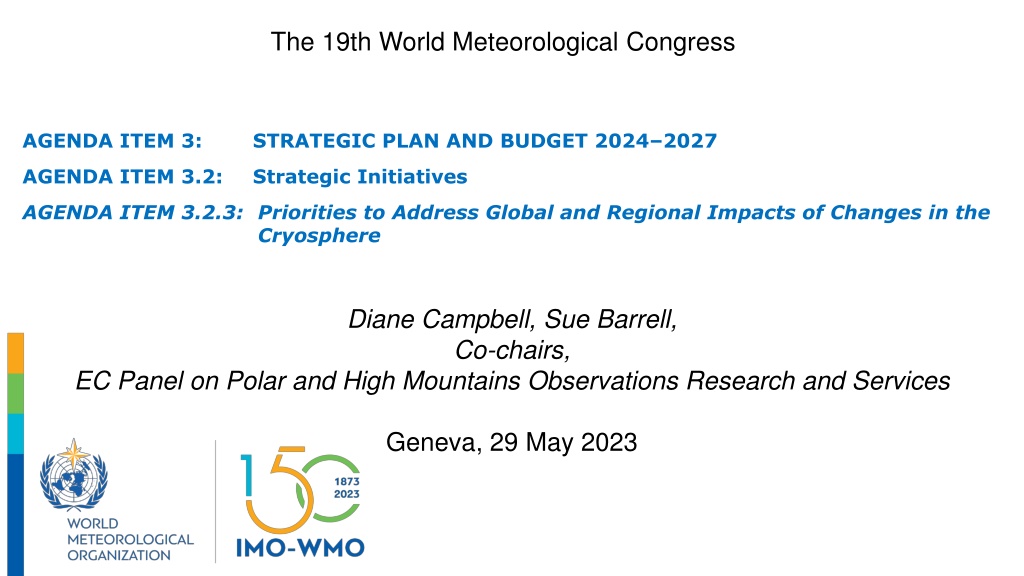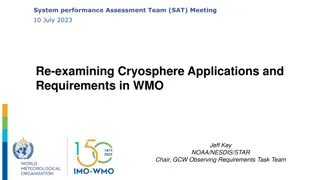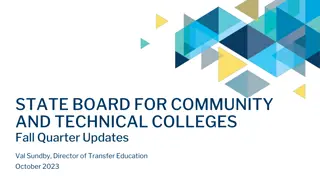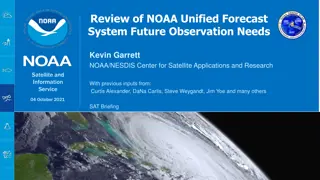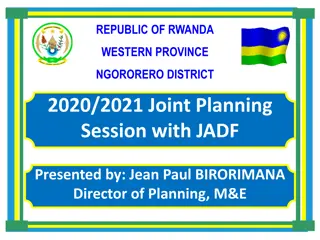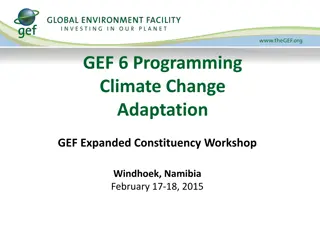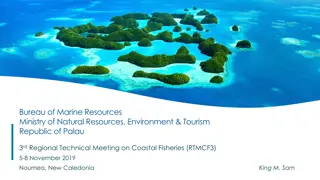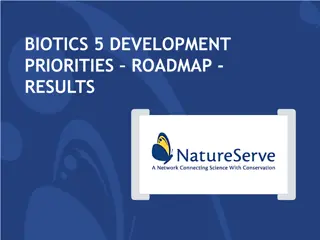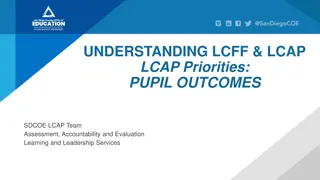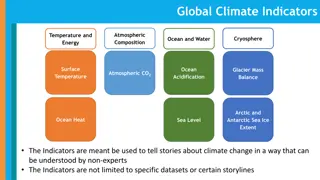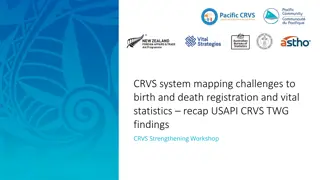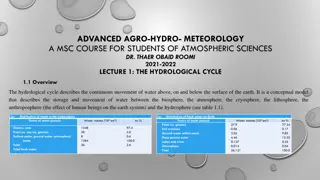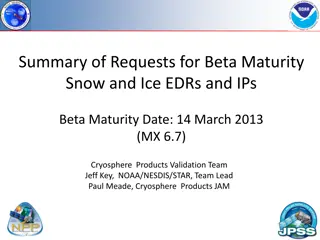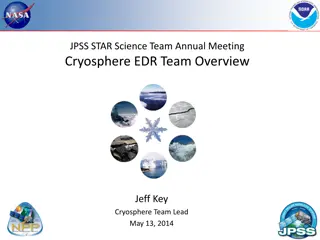Global Impact of Cryosphere Changes: Priorities and Actions
The priorities outlined aim to address the global and regional impacts of changes in the cryosphere, emphasizing the urgent need for action. Endorsed by various organizations and partners, these initiatives focus on building capabilities, forming cross-organizational partnerships, and ensuring the success of an integrated Earth system approach. WMO's historical focus on the cryosphere underscores the importance of responding to accelerated changes for the well-being of communities worldwide.
Download Presentation

Please find below an Image/Link to download the presentation.
The content on the website is provided AS IS for your information and personal use only. It may not be sold, licensed, or shared on other websites without obtaining consent from the author. Download presentation by click this link. If you encounter any issues during the download, it is possible that the publisher has removed the file from their server.
E N D
Presentation Transcript
The 19th World Meteorological Congress AGENDA ITEM 3: STRATEGIC PLAN AND BUDGET 2024 2027 AGENDA ITEM 3.2: Strategic Initiatives AGENDA ITEM 3.2.3: Priorities to Address Global and Regional Impacts of Changes in the Cryosphere Diane Campbell, Sue Barrell, Co-chairs, EC Panel on Polar and High Mountains Observations Research and Services Geneva, 29 May 2023
Draft Resolution 3.2(3)/1 (Cg-19) Priorities to Address Global and Regional Impacts of Changes in the Cryosphere: Outline Why it matters? How did we get here? Next Steps 2
Priorities to Address Global and Regional Impacts of Changes in the Cryosphere Endorse priorities advocated by EC-PHORS together with P/INFCOM, P/SERCOM, RB, C/HCP, C/GCW, Members and partners, to address accelerated changes in the cryosphere, Put the spotlight on capabilities required by Members to respond to the urgency and address emerging risks to communities, worldwide, Connect the dots through cross organizational partnerships at national and regional level leveraging all available cryosphere monitoring and research activities and capabilities Highlight specific actions that would ensure the success of integrated Earth system approach in all work plans (e.g. WIGOS, WIPPS, Data Policy, WMO Service Delivery Strategy, further research). 3
Video to be inserted https://vimeo.com/699339103
WMO has had a focus on the cryosphere for 150 years 2ndIMO Congress (1879) - Resolution : Congress requested that observations at high elevation and of glaciers length and thickness be organized and data shared, to aid in the solution of problems that may present themselves in the future 1879 2nd International Meteorologic al Congress: Cg- 2021 GCW in INFCOM 14(2007) EC-PORS 2013-2022 PPP Cg-IV(1963): the 1stEC Standing Committee on Antarctic Cg-16 (2011) GCW Cg-17 (2015) EC-PHORS Cg-19 2024-27: Draft SO 1.5 Draft Res 3.2(3) 5
Irreversible changes in the global cryosphere will impact adaptation strategies and access to water resources Well over a billion people rely on water from snow and glacier melt, carried downstream by the major river basins of the world (domestic consumption, irrigation, hydropower) By 2050: > 50% of irrigation on global lowlands - from mountain cryosphere runoff 6
Arctic permafrost is melting and is a sleeping giant of greenhouse gases Arctic permafrost stores twice as much carbon as is in the atmosphere, today. Thawing mountains and Arctic permafrost creates increased risk of natural, cascading hazards Soil organic carbon pools (0-3 m depth) for the northern circumpolar permafrost region. (modified from Scientific American, November 2016) Produced by Mapping Specialists, Ltd. 7
Glaciers, Greenland and Antarctica ice sheet melt accounts for about 50% of the sea level rise Significant sea level rise is projected under all emission scenarios Impacts on SIDS and coastal areas will range from significant to extreme Cumulative impacts will be felt from compound events 8
Cryosphere changes in mountain areas are leading to an increased risk of hazards - mass movements (e.g. rockslides, debris flows, glacier detachments) - Glacial Lake Outburst Floods (GLOFs) Pakistan has surveyed 3044 glacial lakes, of which 36 were potentially dangerous, and at high risk for outburst. 9
Need for coordination of activities in Antarctica carried out by Members The Antarctic Treaty applies South of 60 South Latitude, including all ice shelves. This area sits outside of the WMO RA structure. EC-PHORS has operated under the general ToR of RAs with regards to WMO activities in Antarctica, since 2007. Antarctica Observing Network (OSCAR/Surface) 153 operational stations Operated by 24 Members More formal operational and strategic coordination of Members activities in Antarctica would assist WMO and Members in meeting requirements for meteorological data and services and for environmental monitoring and climate research. 10
Priorities to Address Global and Regional Impacts of Changes in the Cryosphere Endorse priorities advocated by EC-PHORS together with P/INFCOM, P/SERCOM, RB, C/HCP, C/GCW, Members and partners, to address accelerated changes in the cryosphere, Put the spotlight on capabilities required by Members to respond to the urgency and address emerging risks to communities, worldwide, Connect the dots through cross organizational partnerships at national and regional level leveraging all available cryosphere monitoring and research activities and capabilities Highlight specific actions that would ensure the success of integrated Earth system approach in all work plans (e.g. WIGOS, WIPPS, Data Policy, WMO Service Delivery Strategy, further research). 11
Draft Resolution 3.2(3)/1 (Cg-19) and Draft Strategic Objective 1.5 Key outputs of Draft SO 1.5 are included as actions in the Draft Resolution 3.2(3) roadmap, reflecting their relationship with the existing plans, e.g. the WMO Service Delivery Strategy. Draft Resolution 3.2(3) puts the spotlight on the overall capabilities required by Members to respond to the urgency and address emerging risks from the changes in the cryosphere to communities, worldwide, and delivered through TCs, RB, HCP 12
Draft Resolution 3.2(3)/1 (Cg-19) High level priorities (1) The urgency of global and regional emerging risks from the changing cryosphere in a changing climate, is understood and reflected in the workplans of WMO bodies (LTGs 1, 2, 3, and 4); (2) Collaborative and coordinated technical mechanisms are optimized to support advancing service delivery by Members to address gaps in polar and high mountain regions, all scales (LTGs 1, 2, 3, and 4); (3) Earth system predictions are enhanced through closing gaps in polar and high mountain observations, data sharing, and improved numerical models integrating research on cryospheric processes (LTGs 1, 2, 3 and 4); (4) Partnerships and collaboration with research and external stakeholders advance knowledge sharing and amplify the existing capacity to deliver services, in a regional relevant manner (LTGs 1, 2, 3, 4 and 5); (5) Antarctica: Members collaboration in collecting and sharing observations, conducting research, and developing and providing services, is enhanced (LTGs 1, 2, 3, and 5). 13
1. The urgency of global and regional emerging risks from the changing cryosphere in a changing climate, is understood and reflected in the workplans of WMO bodies and in global frameworks a) High-level, long-term ambitions - for global actions in addressing changes in polar and high mountain regions and their impacts downstream, including on coastal areas and SIDS; b) Improved understanding of societal risks and opportunities - where cryosphere related impacts are felt, and advocate for their representation in the WMO strategies; c) Incorporate cryosphere related services requirements in the WMO Strategy for Service Delivery; d) Focused approach in the work plans of WMO bodies - to enhancing the resilience of vulnerable communities and regions, through coordination, knowledge and capacity-sharing, rapid technology adoption, and enhanced services; e) Advocacy for action through global campaigns - address information needs while balancing technical, scientific, operational, funding mechanisms, and policy aspects. 14
2. Collaborative and coordinated technical mechanisms are optimized to promote and support advancing service delivery by Members, to address gaps in polar and high mountain regions, at all scales a) Develop requirements and plan pilot projects for regional mountain monitoring and warning centres, to address the intertwined hydrological, climate, ecosystem, and social issues and policies b) Within the framework of WIPPS, explore the potential to include new types of Regional Specialized Meteorological Centres, e.g. mountain monitoring and warning centres; c) Continue the implementation of Polar Regional Climate Centre Networks and Outlook Forums (Arctic, Antarctic, the Third Pole), with partners, d) Integrate cryospheric and related environmental hazards in the Multi-Hazard Early Warning System (MHEWS) and the catalogue of hazardous events, which would enable monitoring and EWSs, e) Develop consistent indicators for monitoring and reporting on cryosphere changes and their impacts, which are to be included in the portfolio of weather and hydroclimate information services. f) Use the opportunity of of internationally coordinated research projects, e.g. the Year of Polar Prediction (YOPP) for translating mature research results into sustainable services, through appropriate mechanisms. 15
3. Earth system predictions are enhanced through closing gaps in polar and high mountain observations, improving data sharing, and improved numerical models integrating mature research related to cryospheric processes (a) Initiate the development of global high mountain Earth system forecasting and prediction capabilities, including NWP verification and validation over high mountain areas; (b) Foster the organization of demonstration projects to advance the effectiveness of forecasts and warning services for regions affected by the rapid changes in the cryosphere; (c) Establish a framework for multinational observatories (supersites) hosting projects on addressing critical knowledge gaps, testing new technologies, and EWS solutions; (d) Enhance the free and open exchange of data related to the cryosphere (WMO Unified Data Policy) and ensure integration through WIGOS, WIS, and WIPPS; (e) Foster the integration of cryosphere data into numerical and Earth system models -improved predictability and understanding of impacts of changes in the cryosphere; (f) Sustain advocacy for critical satellite observations and data over polar and high mountain regions - risk monitoring and assessments and the development of services. 16
4. Partnerships and collaboration with research and external stakeholders advance knowledge sharing and amplify the existing capacity to deliver services, in a regional relevant manner (a) Take stock of and report on current and past research activities and results on changes in the cryosphere and their societal impacts to identify opportunities for transfer of research to operations, e.g. forecasts, warnings, hydrology, water resources, carbon release from the thawing permafrost, etc.; (b) Advocate for the representation of cryosphere related policy priorities of vulnerable regions in the work plans of WMO bodies; (c) Advocate for the co-production of knowledge through coordinated integrated research projects in high mountain regions and Antarctica, modelled on the Polar Prediction Project; (d) Pursue mutually beneficial engagements and partnerships with key partners, broader international research and academia, across the full value cycle, in a regionally relevant manner; (e) Actively engage early career scientists and foster capacity development activities for local experts and communities. 17
5. Antarctica: Members collaboration in collecting and sharing observations; conducting research; and developing and providing services, is enhanced (a) Provide recommendations on the role of WMO on the coordination of activities of Members with an interest in Antarctica and its Southern Ocean environment (South of 60 S); (b) Engage Members with interests on Antarctica to evolve the necessary structure in WIPPS and WIGOS to meet the information needs in support of their activities, integrating mature research results and considering the concepts of Regional WIGOS Centres, Regional Specialized Meteorological Centres and that for the Antarctic RCC-Network; (c) Recommend a convening role for WMO on the understanding of the Antarctica icesheet melt and its impacts on sea level rise, globally: focus on monitoring and standardization and distribution of in-situ and satellite data over Antarctica, data assimilation, and communication of uncertainties as they relate to impacts; (d) Develop an integrated service delivery model for Antarctic weather and marine services, a coordinating role of WMO, in consultation with Members Antarctic operators and parties to ATCM; (e) Maintain active engagements between WMO structures and other groups or bodies 18
Draft Resolution 3.2(3)/1 (Cg-19) Decides to endorse the five high-level priorities identified in the annex to this resolution, which align with the five LTGs of the Strategic Plan and serve as a roadmap for the work of the WMO bodies, Requests EC to: (1) Ensure that the five priorities are reflected in the WMO Operating Plan 2024 2027, as aligned with LTG; (2) Update ToRs of EC-PHORS to serve as a mechanism for engagement and advocacy; Requests INFCOM, SERCOM, RB, RAs, in collaboration with EC-PHORS and other relevant WMO bodies, to integrate the actions identified in the annex to this resolution, in their work programmes; Urges Members to: (1) Mobilize national institutions with relevant programmes to make available their cryosphere data (2) Enhance their observing and monitoring programmes and services to enable the delivery of these priorities; (3) Maintain efforts for national coordination of agencies with responsibilities in polar and high mountain regions; (4) Support the implementation of this resolution with in-kind and financial contributions; Requests the Secretary-General: (1) To make the necessary resources available, to the extent possible; (2) To bring the present resolution to the attention of all concerned. 19
Thank you wmo.int
